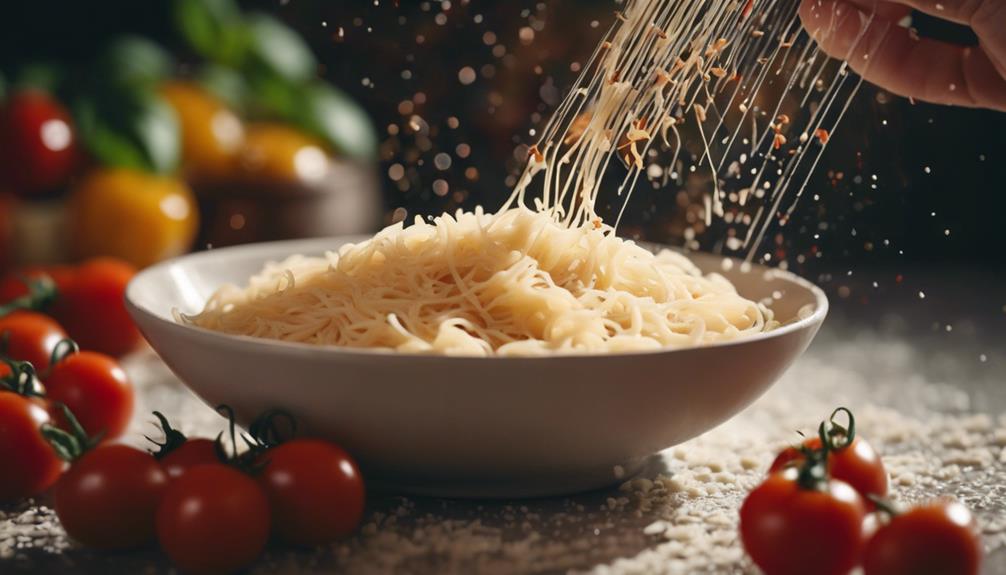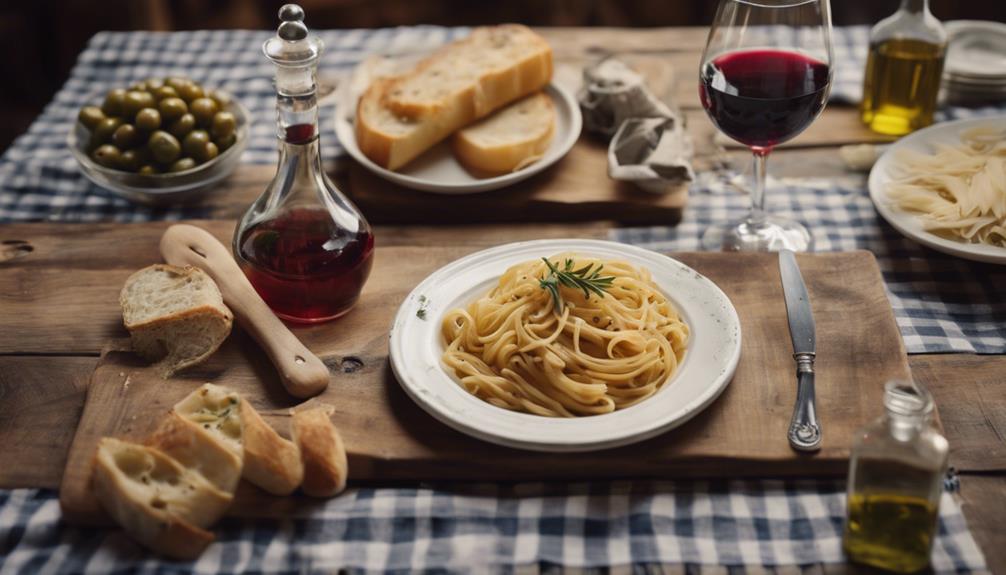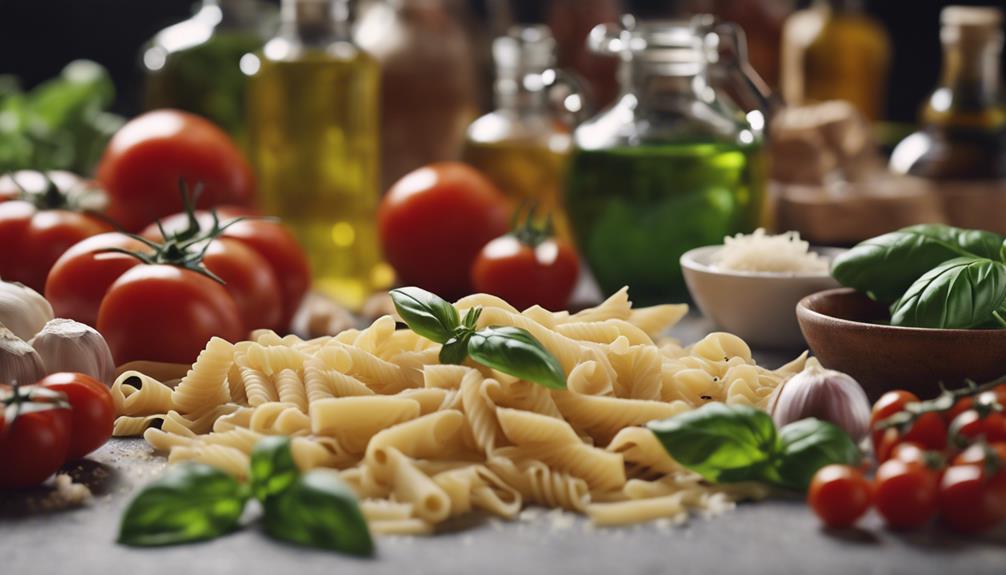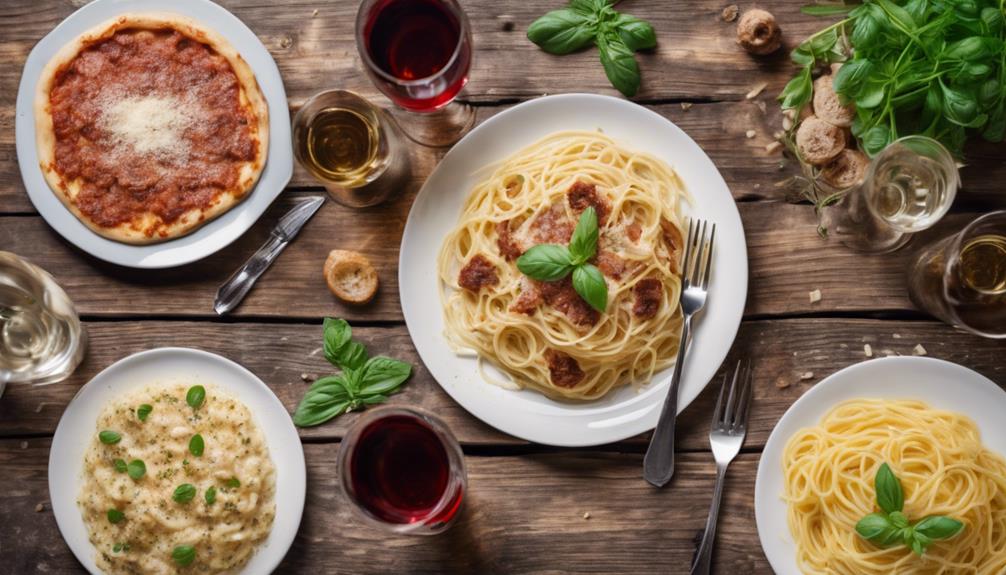In Italian cuisine, high-quality olive oil is the secret ingredient that will revolutionize your cooking. This essential element adds genuine flavors, enhances dishes with its golden hue, and enriches the aroma of your culinary creations. Olive oil is versatile for searing, sautéing, and frying, creating caramelized crusts, intensifying flavors, and allowing natural juices to shine. When paired with ingredients like tomatoes, basil, and garlic, olive oil brings out unique taste profiles. The health benefits of olive oil are extensive, supporting heart health and overall well-being. Keep an eye out to learn more about the enchantment of olive oil in Italian cooking.
Key Takeaways
- Olive oil is the essential ingredient in Italian cuisine that elevates flavors and adds authenticity.
- Its versatility in cooking techniques like searing, sautéing, and frying enhances dishes.
- Pairing olive oil with ingredients like tomatoes and basil enhances natural tastes.
- High-quality olive oil varieties from regions like Tuscany and Sicily provide distinct flavors.
- Olive oil offers health benefits like promoting heart health, reducing bad cholesterol, and improving insulin sensitivity.
The Magic of Olive Oil
Discover the transformative power of olive oil in Italian cuisine. Olive oil holds a revered status in Italian culinary traditions, being a fundamental ingredient in countless dishes.
Extra-virgin olive oil, known for its exceptional taste and quality, reigns supreme in Italian kitchens. Its versatility extends from searing meats to sautéing vegetables, and even as a finishing touch by drizzling over dishes to enhance flavors.
In Italian cooking, olive oil takes precedence over butter due to its health benefits and distinctive flavor profile. The rich history of olive oil intertwines with the essence of Italian cuisine, where high-quality olive oil is a non-negotiable element for achieving authentic flavors.
Elevate your dishes with the golden hue and fragrant aroma of olive oil, allowing it to be the magical touch that transforms ordinary recipes into extraordinary culinary experiences. Embrace the heritage and tradition of Italian cuisine by embracing the magic of olive oil in your cooking endeavors.
Flavor Enhancer in Italian Cooking
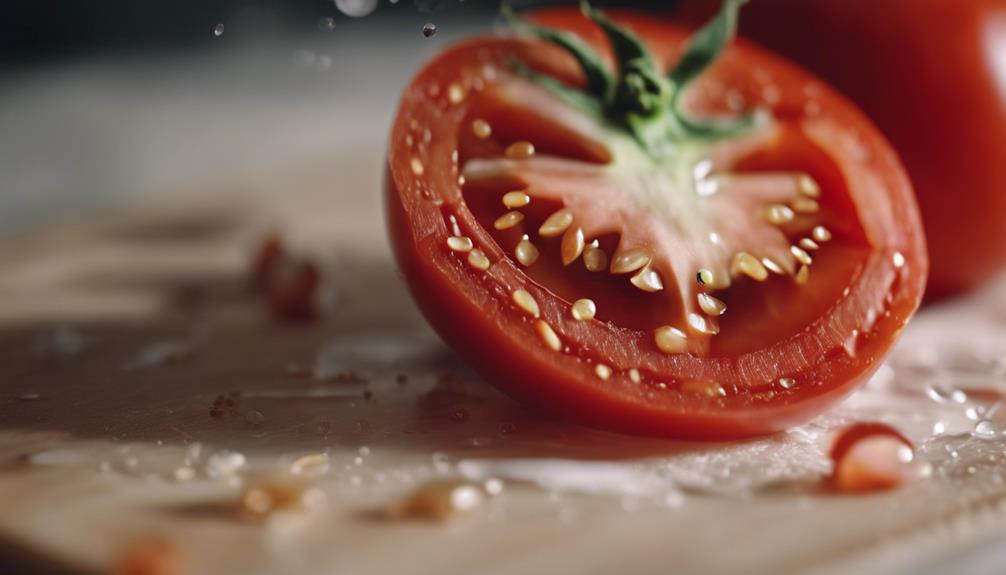
In Italian cooking, olive oil serves as a key flavor enhancer, renowned for its fruity and peppery notes that elevate dishes to new heights.
When selecting olive oil for your Italian recipes, opt for extra-virgin varieties as they offer the most robust flavor profile.
High-quality sea salt is another essential ingredient in Italian cuisine, essential for balancing and enhancing flavors. A sprinkle of sea salt not only brings out the natural tastes of the ingredients but also adds depth to your dishes.
Fresh garlic, when used in moderation, infuses Italian recipes with a rich aroma and depth of flavor. Whether minced, sliced, or crushed, garlic contributes a savory element that's vital to many traditional Italian dishes.
Cooking Techniques With Olive Oil
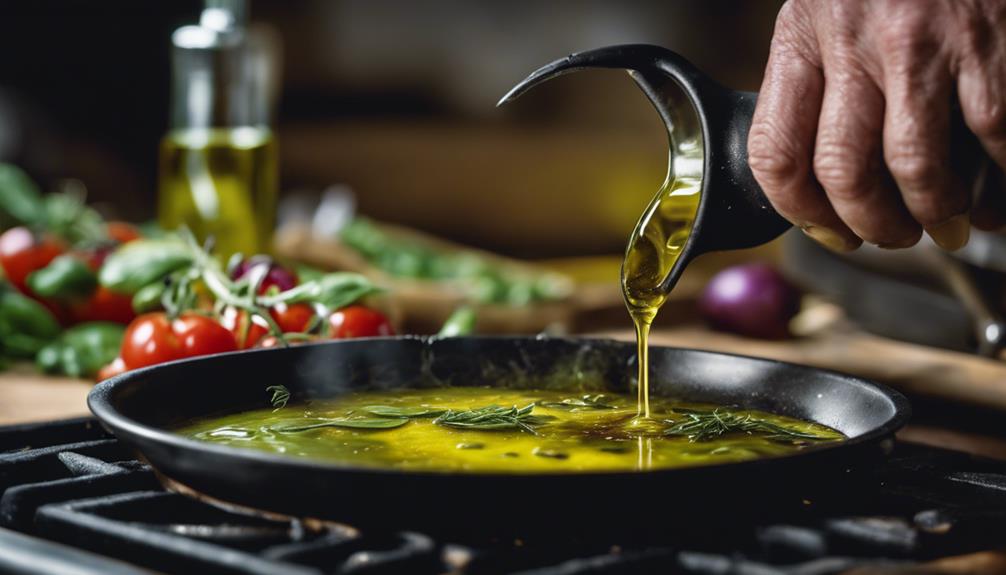
Utilize olive oil as a versatile cooking medium to enhance the flavors of your Italian dishes and achieve exquisite culinary results.
When using olive oil in Italian cooking, consider these essential techniques:
- Searing: Heat a generous amount of extra-virgin olive oil in a pan before adding ingredients to create a beautiful caramelized crust, enhancing the overall flavor profile of your dish.
- Sautéing: Use olive oil to gently cook vegetables, meats, or seafood over medium heat, allowing the ingredients to release their natural juices and infuse with the rich taste of the oil.
- Frying: Olive oil's high smoke point makes it ideal for frying delicate foods like arancini or zucchini flowers, imparting a light and crispy texture without overwhelming the original flavors.
In Italian cuisine, mastering the art of cooking with olive oil is key to achieving authentic and delicious results that pay homage to the traditional flavors of Italy.
Pairing Olive Oil With Ingredients
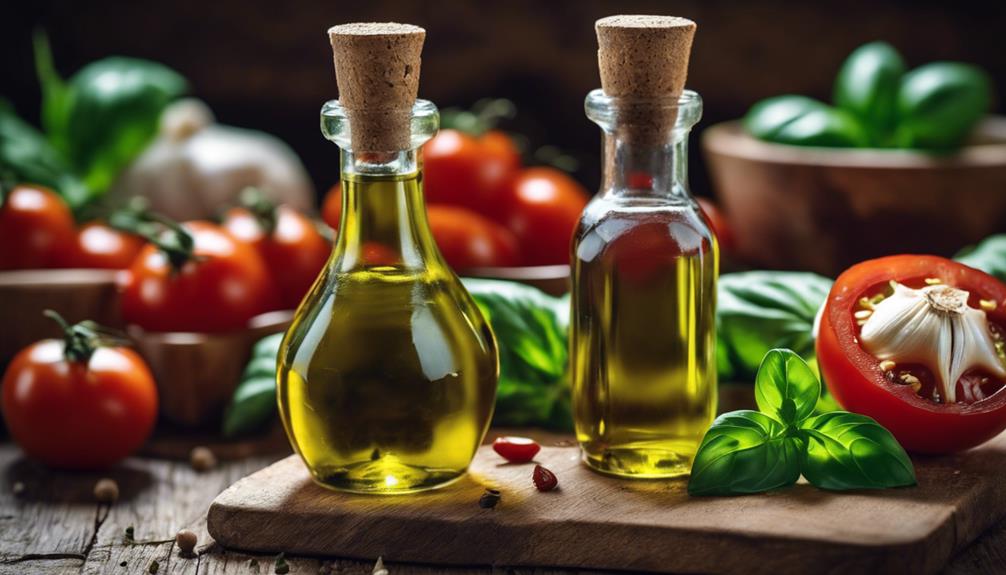
When it comes to Italian cuisine, pairing olive oil with ingredients is essential for enhancing natural tastes.
Complementing flavors like tomatoes, basil, and garlic with high-quality extra virgin olive oil can elevate the overall dish.
Selecting the right variety of olive oil, whether for cooking, dressing salads, or finishing dishes, is vital for achieving authentic Italian flavors.
Complementing Flavors
Enhance the flavors of your Italian dishes by skillfully pairing olive oil with ingredients like tomatoes, garlic, and basil.
- Tomatoes: When combined with olive oil, tomatoes benefit from the fruity notes of the oil, intensifying their natural sweetness and acidity. The marriage of these two ingredients creates a harmonious balance that's fundamental in many Italian recipes.
- Garlic: Olive oil enhances the pungent and aromatic qualities of garlic, creating a flavorful base for various Italian dishes. The marriage of these two ingredients results in a robust and savory profile that forms the backbone of many classic recipes.
- Basil: The peppery and herbal notes of basil are elevated when paired with olive oil, adding freshness and complexity to Italian dishes. This dynamic duo creates a vibrant and fragrant combination that's essential in dishes like Caprese salad or pesto.
Enhancing Natural Tastes
Enhance the inherent flavors of your Italian dishes by skillfully pairing olive oil with a variety of ingredients, amplifying the natural tastes with each delicious combination.
Olive oil plays a pivotal role in traditional Italian cooking, bringing out the essence of ingredients like tomatoes, basil, and garlic. The quality and freshness of the olive oil used can greatly impact the overall taste of the dish, making it essential to choose wisely.
When paired with fresh herbs such as basil, olive oil not only enhances the aroma but also boosts the taste profile of the dish. Using olive oil as a base for cooking helps infuse dishes with a rich and authentic Italian flavor, creating a depth that's characteristic of Italian cuisine.
Selecting Quality Varieties
To enhance the flavors of your Italian dishes, skillfully pair different varieties of olive oil with complementary ingredients, amplifying the natural tastes with each delicious combination.
When selecting olive oils for your culinary creations, consider the following tips:
1. Extra Virgin Olive Oil and Fresh Herbs:
Opt for extra-virgin olive oil when incorporating fresh herbs like basil into your Italian dishes. This pairing enhances the herbaceous notes, adding depth to your recipes.
2. Peppery and Robust Oils with San Marzano Tomatoes:
Choose a peppery and robust olive oil to complement the sweetness of San Marzano tomatoes in sauces and bruschetta. This combination creates a harmonious blend of flavors that will elevate your dishes.
3. Light and Fruity Oils for Finishing Touches:
Light and fruity olive oil varieties work wonders when drizzled over salads or used to finish dishes like Caprese. Their delicate flavors add a invigorating touch to your creations, making them shine in the world of Italian cuisine.
Health Benefits of Olive Oil
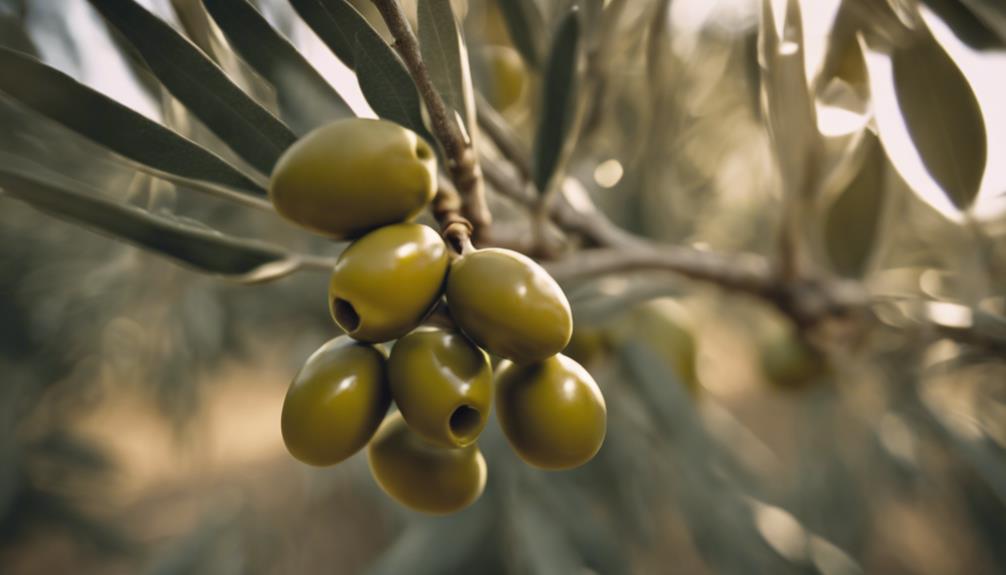
You may be surprised by how incorporating olive oil into your diet can positively impact your health. Olive oil, a key element in Italian cooking, offers a myriad of health benefits. Rich in monounsaturated fats, it aids in lowering bad cholesterol levels, promoting heart health, and reducing the risk of cardiovascular diseases.
Additionally, olive oil contains antioxidants like vitamins E and K, which possess anti-inflammatory properties and may help protect against chronic diseases.
Moreover, the significant oleic acid content in olive oil plays an essential role in improving insulin sensitivity and regulating blood sugar levels. Studies have shown that regular consumption of olive oil is associated with a reduced risk of stroke and may contribute to overall longevity and well-being.
Choosing the Best Olive Oil
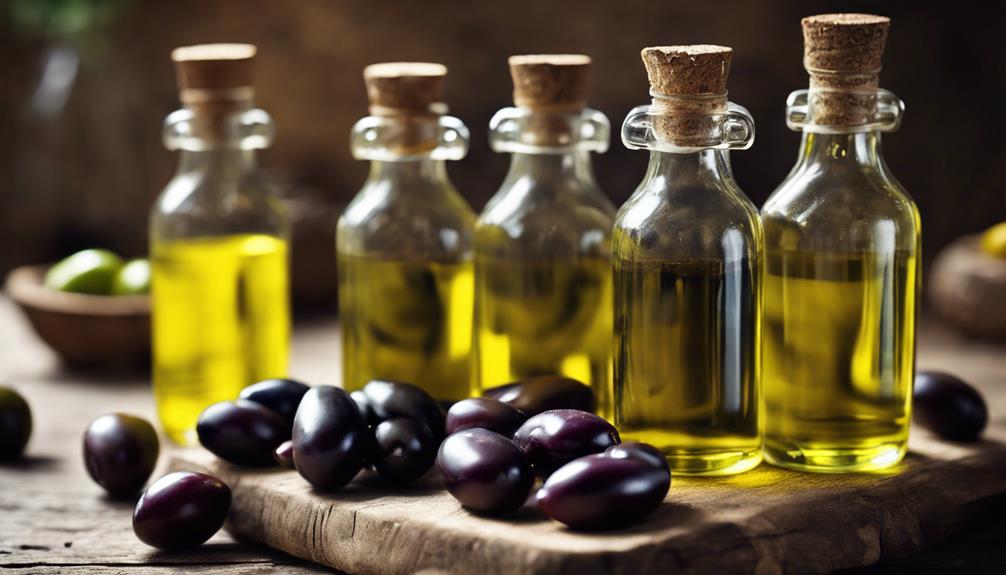
When selecting the best olive oil for your Italian dishes, consider different grades, like extra-virgin, for superior quality.
Look for oils made from early harvest olives to enjoy a robust, peppery flavor in your cooking.
Understanding these distinctions will help you enhance the taste of your dishes, whether you're searing, dressing, or finishing them.
Olive Oil Grades
When selecting the best olive oil, taking into account its grade is crucial for experiencing the true flavors and benefits of this transformative ingredient in Italian cuisine. Here are some key points to ponder:
- Extra-Virgin Olive Oil: This is the highest grade of olive oil, extracted solely by mechanical means without any chemical treatment. It offers intense flavor and numerous health benefits, making it a staple in Italian dishes.
- Virgin Olive Oil: Slightly lower in quality than extra-virgin, virgin olive oil has a higher acidity level and a milder taste. It's a good option for those looking for a balance between flavor and affordability.
- Pure Olive Oil: A blend of virgin and refined olive oils, pure olive oil lacks the distinct flavor and health benefits of virgin oils. It's suitable for cooking methods that don't require the olive oil flavor to shine through.
Consider these grades when choosing olive oil for your Italian culinary adventures to make the most out of this essential ingredient.
Flavor Profiles
For an authentic Italian culinary experience, selecting the best olive oil with the ideal flavor profile is essential to elevate your dishes to the next level.
When choosing olive oil for Italian cuisine, consider the flavor profiles different varieties offer. Extra-virgin olive oil from early harvest olives provides a spicy and peppery taste that can enhance the flavors of your Italian dishes.
Authentic Italian olive oil should be fresh and clearly labeled with its place of origin to guarantee the best taste. Investing in high-quality olive oil is vital as it adds a distinct Italian touch to your cooking.
Olive oil has been a staple in Italian cuisine for centuries, favored over butter in most regions due to its rich flavor and cooking properties. To bring out the best flavors in your dishes, it's common practice in traditional Italian cooking to use olive oil generously, both for cooking and finishing touches.
Cooking Applications
Consider the best olive oil for your Italian dishes to enhance their flavors and elevate your culinary creations to new heights.
When choosing olive oil for your pasta dishes and other Italian meals, keep in mind these key points:
- Extra-Virgin Excellence: Opt for extra-virgin olive oil, known for its rich flavor and low acidity, which is crucial for authentic Italian cooking.
- Versatile Culinary Companion: Use olive oil for various cooking techniques like searing, sautéing, and dressing salads, as well as a finishing touch to bring out the flavors in your dishes.
- Quality Matters: Look for olive oils labeled DOP (Denominazione di Origine Protetta) to guarantee authenticity and high quality. Seek out oils from regions such as Tuscany, Sicily, and Umbria for unique flavor profiles that complement specific Italian dishes perfectly.
Recipes to Try With Olive Oil
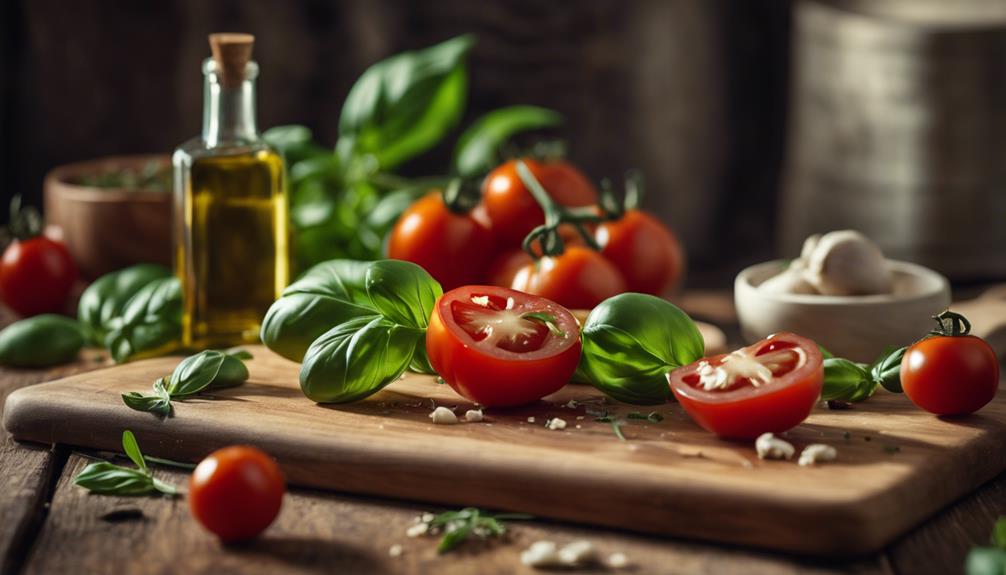
Discover flavorful ways to incorporate olive oil into your Italian dishes. When it comes to Italian food, olive oil plays a crucial role in enhancing the overall taste and texture of various dishes. To help you elevate your cooking, here are some classic recipes you can try using olive oil:
| Recipe | Description | Ingredients |
|---|---|---|
| Caprese Salad | A simple yet delicious salad featuring | Tomatoes, mozzarella, basil, |
| fresh tomatoes, mozzarella, basil, and a | extra-virgin olive oil, salt, | |
| drizzle of extra-virgin olive oil. | pepper | |
| Aglio e Olio Pasta | A traditional pasta dish from Italy | Spaghetti, garlic, red pepper, |
| made with garlic, red pepper, and olive | parsley, extra-virgin olive | |
| oil for a flavorful and easy meal. | oil, salt, pepper | |
| Bruschetta | Toasted bread topped with a mixture of | Baguette, tomatoes, garlic, |
| tomatoes, garlic, basil, and olive oil, | basil, extra-virgin olive oil, | |
| creating a fresh and vibrant appetizer. | salt, pepper | |
| Pesto Sauce | A classic Italian sauce made with fresh | Basil, pine nuts, garlic, |
| basil, pine nuts, garlic, Parmesan | Parmesan cheese, extra-virgin | |
| cheese, and a generous amount of olive | olive oil, salt | |
| oil for a rich and flavorful pasta dish. |
Experiment with these recipes to fully appreciate the versatility and depth of flavor that olive oil can bring to your Italian culinary creations.
Frequently Asked Questions
What Is the Most Important Ingredient in Italian Cooking?
The most important ingredient in Italian cooking is olive oil. It has been a staple for centuries, essential for searing and cooking various dishes. Its versatility and tradition make it the cornerstone that transforms your Italian cooking forever.
What Is the Secret Ingredient in Italian Food?
When it comes to Italian food, the secret ingredient that will transform your cooking forever is olive oil. It has been a staple for centuries, enhancing flavors and textures in traditional dishes.
What Is the Holy Grail of Italian Cooking?
In Italian cooking, the holy grail is balance. Olive oil, sea salt, garlic, tomatoes, and basil harmonize to create depth and aroma. Master these essentials to elevate your dishes with authenticity and flavor.
What Is the Holy Trinity in Italian Cooking?
The holy trinity in Italian cooking consists of garlic, olive oil, and tomatoes. They form the base for many traditional dishes, providing aroma, richness, acidity, and sweetness. Mastering this trio is key to authentic Italian flavors.
What is the Key Ingredient in Romano’s Signature Dish that Transforms the Flavor?
When it comes to romano’s signature italian dish, the key ingredient that transforms the flavor is the aged Pecorino Romano cheese. This salty and sharp cheese adds a unique depth and richness to the dish, making it a standout in Italian cuisine.
Conclusion
To sum up, olive oil is the key ingredient that will revolutionize your Italian cooking experience. Its versatile flavor profile, culinary applications, and health benefits make it a must-have in any kitchen.
So, next time you're preparing a meal, ask yourself: Could a drizzle of high-quality olive oil be the missing ingredient that takes your dish from good to exceptional? The answer may just surprise you.
